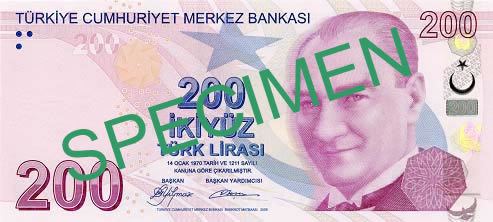Code TRY Exponent 2 Symbol ₺ | Number 949 ⁄100 Kuruş | |
 | ||
Plural The language(s) of this currency does not have a morphological plural distinction. | ||
The Turkish lira (Turkish: Türk lirası; sign: ₺; code: TRY; usually abbreviated as TL) is the currency of Turkey and the Turkish Republic of Northern Cyprus. The Turkish lira is subdivided into 100 kuruş.
Contents
Ottoman lira (1844–1923)
The lira, along with the related currencies of Europe and the Middle East, has its roots in the ancient Roman unit of weight known as the libra which referred to the Troy pound of silver. The Roman libra adoption of the currency spread it throughout Europe and the Near East, where it continued to be used into medieval times. The Turkish lira, the French livre (until 1794), the Italian lira (until 2002), and the British pound (a translated version of the Roman libra; the word "pound" as a unit of weight is still abbreviated as "lb.") are the modern descendants of the ancient currency.
The Ottoman lira was introduced as the main unit of currency in 1844, with the former currency, kuruş, remaining as a 1⁄100 subdivision. The Ottoman lira remained in circulation until the end of 1927.
First Turkish lira (1923–2005)
Historical banknotes from the second, third and fourth issues have portraits of İsmet İnönü on the obverse side. This change was done according to the 12 January 1926 issue of the official gazette and canceled by the Democrat Party after World War II.
Exchange rates
After periods of the lira pegged to the British pound and the French franc, a peg of 2.8 Turkish lira = 1 U.S. dollar was adopted in 1946 and maintained until 1960, when the currency was devalued to 9 Turkish lira = 1 dollar. From 1970, a series of hard, then soft pegs to the dollar operated as the value of the Turkish lira began to fall.
The Guinness Book of Records ranked the Turkish lira as the world's least valuable currency in 1995 and 1996, and again from 1999 to 2004. The Turkish lira had slid in value so far that one original gold lira coin could be sold for 154,400,000 Turkish lira before the 2005 revaluation.
Second Turkish lira (2005–present)
In December 2003, the Grand National Assembly of Turkey passed a law that allowed for redenomination by the removal of six zeros from the Turkish lira, and the creation of a new currency. It was introduced on 1 January 2005, replacing the previous Turkish lira (which remained valid in circulation until the end of 2005) at a rate of 1 second Turkish lira (ISO 4217 code "TRY") = 1,000,000 first Turkish lira (ISO 4217 code "TRL"). With the revaluation of the Turkish lira, the Romanian leu (also revalued in July 2005) briefly became the world's least valued currency unit. At the same time, the Government introduced two new banknotes called TRY100 and TRY50.
In the transition period between January 2005 and December 2008, the second Turkish lira was officially called Yeni Türk Lirası (New Turkish lira). It was officially abbreviated "YTL" and subdivided into 100 new kuruş (yeni kuruş). Starting in January 2009, the "new" marking was removed from the second Turkish lira, its official name becoming just "Turkish lira" again, abbreviated "TL". All obverse sides of current banknotes and reverse sides of current coins have portraits of Mustafa Kemal Atatürk.
Coins
From 1 January 2009, the phrase "new" was removed from the second Turkish lira, its official name in Turkey becoming just "Turkish lira" again; new coins without the word "yeni" were introduced in denominations of 1, 5, 10, 25, 50 kuruş and 1 Turkish lira. Also, the center and ring alloys of the 50 kuruş and 1 Turkish lira coins were reversed.
Exchange rates
Turkish Lira exchange rates became more stable after 2004. In the following years, the yearly average exchange rate of the lira was as follows:
Currency sign
The current currency sign of Turkish lira was created by the Central Bank of the Republic of Turkey in 2012. The new sign was selected after a country-wide contest. The new symbol, created by Tülay Lale, is composed of the letter 'L' shaped like a half anchor, and embedded double-striped letter 'T' angled at 20 degrees.
Prime Minister Recep Tayyip Erdoğan announced the new symbol on 1 March 2012. At its unveiling, Erdoğan explained the design as "the anchor shape hopes to convey that the currency is a 'safe harbor' while the upward-facing lines represent its rising prestige".
In May 2012, the Unicode Technical Committee accepted the encoding of a new character U+20BA ₺ Turkish lira sign for the currency sign, which was included in Unicode 6.2 released in September 2012.
